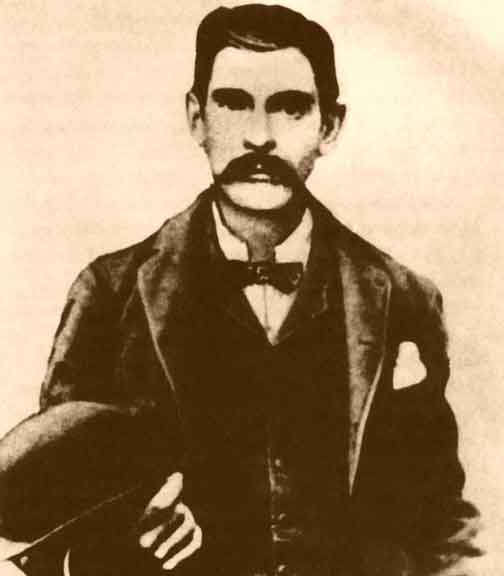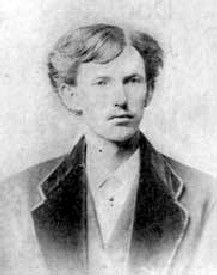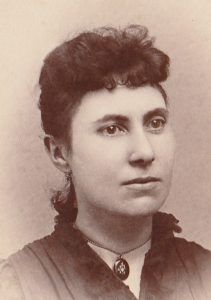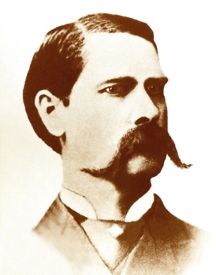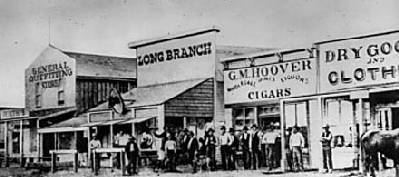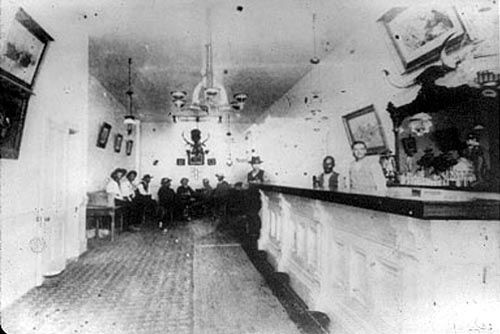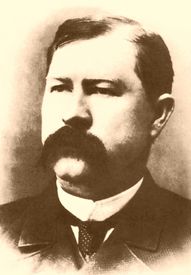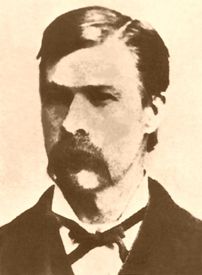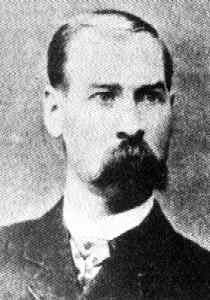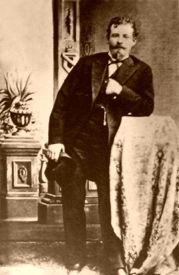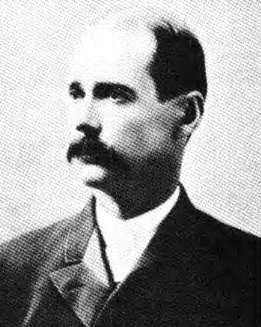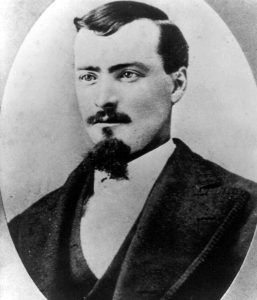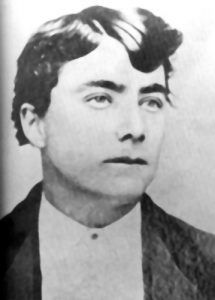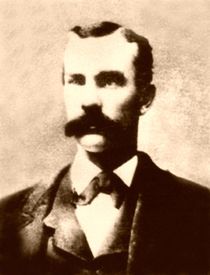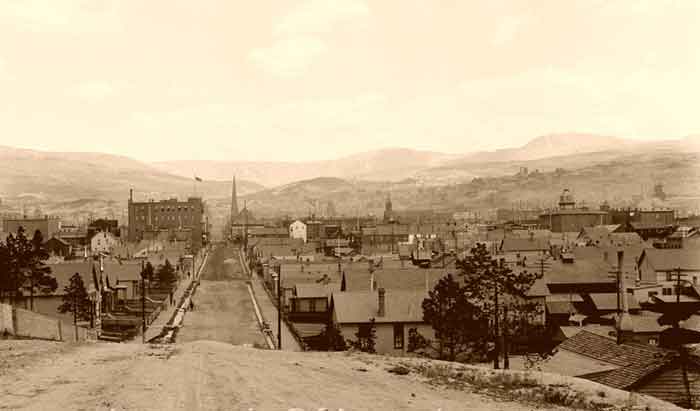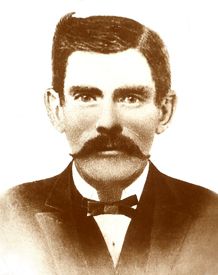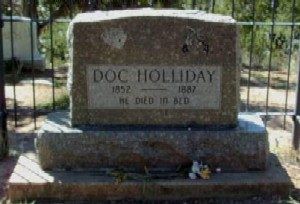“I found him a loyal friend and good company. He was a dentist whom necessity had made a gambler; a gentleman whom disease had made a vagabond; a philosopher whom life had made a caustic wit; a long, lean blonde fellow nearly dead with consumption and, at the same time, the most skillful gambler and nerviest, speediest, deadliest man with a six-gun I ever knew.”
– Wyatt Earp speaking of Doc Holliday
Doc Holliday was a gambler, vagabond, gentleman, and gunfighter. A friend to Wyatt Earp, he was deputized in Tombstone, Arizona, before the famous gunfight at the O.K. Corral.
Doc Holliday’s father, Henry B. Holliday, was a trained pharmacist. He served in several wars, including the Cherokee Indian War, and the Mexican-American War, and was a Major in the Confederate Army during the Civil War. After serving in the Mexican-American War, he returned to Griffin, Georgia, with an orphaned Mexican boy named Francisco Hidalgo. On January 8, 1849, Major Holliday married Alice Jane McKay and, within just a year, had a daughter, Martha Eleanora, who died in infancy. On August 14, 1851, John Henry “Doc” Holliday was born.
In 1857, Major Holliday inherited a piece of land in Valdosta, Georgia. He moved Alice, John, and Francisco to Lowndes County, where John Henry attended grade school at the Valdosta Institute, studying Greek, Latin, and French. Major Holliday quickly became one of the town’s leading citizens, serving two terms as Mayor, acting as Secretary of the County Agricultural Society, was a member of the Masonic Lodge, Secretary of the Confederate Veterans Camp, and the Superintendent of local elections.
When John was just 15, his mother died of consumption (later called tuberculosis) on September 16, 1866. This was a terrible blow to the teenager, as his relationship with his mother was very close. Compounding this loss, his father remarried only three months later.
The family’s status in the community and the fact that his cousin, Robert Holliday, founded the Pennsylvania College of Dental Surgery probably encouraged John’s choice of profession. In 1870 he enrolled in the college in Philadelphia, Pennsylvania, and on March 1, 1872, he earned a Doctor of Dental Surgery degree along with 26 other graduates. Shortly after graduation, Doc Holliday began work as a dentist in the office of Dr. Arthur C. Ford in Atlanta, Georgia.
Though educated and respected, John Henry was a hot-tempered Southerner who was quick to use a gun. On one occasion, African American men were swimming in his favorite swimming hole, and the outraged Doc Holliday started shooting over their heads. While one of the black men shot back, no one was killed. This seems to be the first account of Doc’s love affair with the six-shooter.
Shortly after starting his dental practice, Doc Holliday discovered that he had contracted tuberculosis – most likely from his mother before she died. His adopted Mexican brother was also diagnosed with the disease and later died, so he may have also contracted it from him.
Doc consulted several physicians, who told him he had only a short time to live and was encouraged to move to a dryer climate to extend his life. In October 1873, Doc Holliday packed up and headed for Dallas, Texas, the railroad’s end at the time. However, Bat Masterson would write in 1907 that Doc moved due to the shooting incident back in Georgia.
Initially, Doc worked with another dentist named Dr. John A. Seegar in Dallas. However, as the coughing spells wracked his body during delicate dental procedures, his business declined, and Holliday was forced to find another way to earn a living.
Doc was a most unusual character out west, a highly educated and refined man where such things were uncommon. He was fluent in Latin, played the piano very well, was a “nappy” dresser, and displayed the manners of a Southern gentleman.
His intelligence made him a “natural” at gambling, which quickly became his means of support, where he was both an active participant and a poker and Faro dealer. However, Doc was also miserable, with the knowledge of his impending death. He was moody, a heavy drinker, and perhaps more prone to the life he lived with no fear of death.
The thin and weakened doctor knew that a gambling career was a dangerous profession, requiring that he have the means to protect himself. Dedicated, he started practicing with a six-shooter and a long, wicked knife, honing his skills.
The first account of a gunfight occurred on January 2, 1875, when Doc and a local saloonkeeper named Austin had a disagreement, which quickly turned to violence. While several shots were fired, neither man was struck, and both men were arrested, which was reported in the Dallas Weekly Herald. At first, the local citizens thought the gunfight was amusing until a few days later, when Doc again got into a disagreement, killing a prominent citizen with two carefully aimed bullets.
Fleeing Dallas with a posse behind him, Holliday headed to Jacksboro, Texas, a wild and lawless cowtown near an army post. Doc found a job dealing Faro, carrying a gun in a shoulder holster and another on his hip, along with the knife. Having become an expert shot, he was involved in three more gunfights in a short time. Though he left one man dead in these gunfights, no action was taken against him in the lawless cowtown.
However, in the summer of 1876, disagreement again led to violence, resulting in Doc’s killing a soldier from Fort Richardson, which brought the United States Government into the investigation. A reward was offered for his capture, and he was aggressively pursued by the Army, Texas Rangers, U.S. Marshals, local lawmen, and simple citizens anxious to collect the bounty.
Aware of the imminent hanging if captured, Doc fled for his life to Apache country in Kansas Territory (now Colorado). Making stops in Pueblo, Leadville, Georgetown, and Central City, he left three more dead bodies in his wake. Finally, settling down in Denver, he assumed the name of Tom Mackey while dealing Faro at Babbitt’s House. Relatively unknown for a while, that changed when he got involved in an argument with Bud Ryan, well-known gambling tough. A fight ensued, and Doc nearly cut Ryan’s head off with his lethal knife. Though Ryan survived, his face and neck were mutilated. Public resentment forced Doc to run again, first to Wyoming, then New Mexico, and finally back to Texas, where he would meet Wyatt Earp and “Big Nose” Kate at Fort Griffin.
While dealing cards at John Shanssey’s Saloon, Doc met Mary Catherine Elder Haroney, who went by many names but was most often known as “Big Nose” Kate. While the dance hall girl and prostitute was attractive, she had a prominent nose. Kate was tough, stubborn, and with a temper that matched Doc’s. She said she worked the business because she liked it, belonging to no man nor any house!
While traveling from Dodge City, Kansas, Wyatt Earp was on the trail of a train robber, Dave Rudabaugh. After being issued an acting commission as U.S. Deputy Marshal to pursue the outlaw out of state, he followed Rudabaugh’s trail for 400 miles.
Wyatt visited the largest saloon in town, Shanssey’s, asking about Rudabaugh. Owner John Shanssey said that Rudabaugh had been there earlier in the week but didn’t know where he was bound. He directed Wyatt to Doc Holliday, who had played cards with Rudabaugh.
Wyatt was skeptical about talking to Holliday, as it was well-known that Doc hated lawmen. However, when Wyatt found him that evening at Shanssey’s, he was surprised at Holliday’s willingness to talk. Doc told Wyatt that he thought Rudabaugh had back-trailed to Kansas. Wyatt wired this information to Bat Masterson, Sheriff in Dodge City, and the news was instrumental in apprehending Rudabaugh. The unlikely pair formed a friendship in Shanssey’s that would last for years.
In 1877, Doc dealt cards to a local bully named Ed Bailey, who was accustomed to having his way without question. Bailey was unimpressed with Doc’s reputation; to irritate him, he kept picking up the discards and looking at them. Looking at the discards was strictly prohibited by the rules of Western Poker, a violation that could force the player to forfeit the pot.
Though Holliday warned Bailey twice, the bully ignored him and picked up the discards again. This time, Doc raked in the pot without showing his hand or saying a word. Bailey immediately brought out his pistol from under the table, but before the man could pull the trigger, Doc’slethal knife slashed the man across the stomach. With blood spilled everywhere, Bailey lay sprawled across the table.
Knowing that his actions were in self-defense, Doc did not run. However, he was still incarcerated in a local hotel room, as the town had no jail. Bully or not, a vigilante group formed to seek revenge on Holliday. Knowing that the mob would quickly overtake the local lawmen, “Big Nose” Kate devised a plan to free Doc from his confines. Setting fire to an old shed, it began to burn rapidly, threatening to engulf the entire town. As everyone else was fighting the fire, she confronted the officer guarding Holliday with a pistol in each hand, disarmed the guard, and the two escaped.
Dodge City
Hiding out at night, they headed to Dodge City on stolen horses in the morning, registering at Deacon Cox’s Boarding House as Dr. and Mrs. J.H. Holliday. Doc appreciated what Kate did for him so much that he was determined to make her happy and gave up gambling, hanging up his doctor’s shingle again. In return, Kate promised to give up the life of prostitution and stop hanging about the saloons.
However, Kate couldn’t stand the quiet and boredom of respectable living. She told Doc that she was returning to the bright lights and excitement of the dance halls and gambling dens. Consequently, the two split up, as they were destined to do many times during the remainder of Doc’s life.
Doc went back to gambling, frequenting the Alhambra and dealing cards at the Long Branch Saloon. Though Dodge City citizens thought the friendship between Wyatt and Doc was strange, Wyatt ignored them, and Doc kept to the law while in Dodge City.
While Doc was dealing Faro in the Long Branch Saloon one night, several Texas cowboys arrived with a herd of cattle. After many weeks on the trail, the rowdy cowboys were ready to “let loose.” Leading the cowboy mob was Ed Morrison, whom Wyatt had humiliated in Wichita, Kansas, and a man named Tobe Driskill. The cowboys rushed the town, galloping down Front Street with guns blazing, blowing out shop windows. Entering the Long Branch Saloon, they began harassing the customers.
When Wyatt entered the front door, he came face to face with several awaiting gun barrels. Stepping forward, Morrison sneered, “Pray and jerk your gun! Your time has come, Earp!”
Suddenly, a voice sounded behind Morrison. “No, friend, you draw – or throw your hands up!” It was Doc, his revolver to Morrison’s temple. Doc had been in the back room, his card game interrupted by the havoc out front. “Any of you bastards pulls a gun, and your leader here loses what’s left of his brains!” The Cowboys dropped their arms. Wyatt rapped Morrison over the head with his long barrel Colt, then relieving Driskill and Morrison of their arms, he ushered them to the Dodge City Jail. Wyatt never forgot that Doc Holliday saved his life that night in Dodge City. Responding later, Wyatt said, “The only way anyone could have appreciated the feeling I had for Doc after the Driskill-Morrison business would have been to have stood in my boots when Doc came through the Long Branch doorway.”
Later, in their ongoing love-hate relationship, Kate and Doc had another of their frequent, violent quarrels. Furious, Doc saddled his horse and headed out, winding up in Trinidad, Colorado. Shortly after he arrived, he was goaded into a fight by a young gambler known as “Kid Colton.” The “Kid,” wishing to make himself a reputation or unaware of Doc’s gunmanship, wound up in the dusty street with two bullets.
Not wanting to linger, Doc rode on to Las Vegas, New Mexico, where, in the late summer of 1879, he hung out his shingle for the last time. However, this idea was short-lived, and he bought a saloon a few weeks later.
In late August 1879, Doc argued with a local gunman named Mike Gordon. The two took the argument to the street, where Doc politely invited Gordon to start shooting whenever he felt like it. Gordon accepted this invitation and died with three shots in his belly.
Again, a lynch mob formed with plans to lynch Holliday, and Doc returned to Dodge City. However, he arrived only to find that Wyatt had gone to a new silver strike in Tombstone, Arizona. Big Nose Kate was also nowhere to be seen in Dodge City. There being nothing to hold him there, Doc struck out West, bound for Tombstone.
Unknown to Doc, “Big Nose” Kate was also en route to the new boomtown of Tombstone, and the two ran into each other in Prescott, Arizona. Doc was winning heavily at the tables and pocketing $40,000 in winnings, and Kate was happy to keep him company. In the early summer of 1880, the two reached Tombstone.
When Doc arrived in Tombstone, not only did he find Wyatt, but all of the Earp brothers, including Morgan from Montana, James, who traveled with Wyatt from Dodge City, and Virgil from Prescott, where he had just been made a Deputy U.S. Marshal. Wyatt and his brothers were mining silver, and James was dealing Faro at Vogan’s Saloon. Virgil appointed Wyatt as the acting City Marshal and swore in Morgan as an officer. When the Earps arrived in Tombstone, the outlaw Clanton Gang ran roughshod over the territory and immediately resented the Earps’ arrival. “Old man” Clanton, his sons, Ike, Phin, and Billy, the McLaury brothers, Frank and Tom, Curly Bill Brocius, John Ringo, and their followers lost no time in expressing their displeasure. Holliday was a welcome addition to the Earp’s fight with the “Cowboy” faction. Shortly afterward, Kate ran a boarding house in Globe, Arizona, some 175 miles from Tombstone. However, she was known to often stay with Doc when she visited.
In October 1880, Doc had a dispute with a man named Johnny Tyler in the Oriental Saloon. Though Tyler quickly high-tailed it out of the saloon, Doc and the saloon owner, Milt Joyce, continued to argue.
As usual, the argument turned violent, and Doc, who was drunk then, fired several shots hitting Joyce in the hand and his bartender, Parker, in the toe of his left foot. In retaliation, Milt struck Doc on the head with a pistol. Doc was arrested and charged with assault with a deadly weapon, found guilty, and fined $20 for assault and battery plus $11.25 in court costs.
When “Big Nose” Kate visited Holliday, they were known to have frequent arguments, most of which were not serious until Kate got drunk. Her drunkenness often escalated to abuse, and in early 1881, Doc had finally had enough and threw her out.
On March 15, 1881, four masked men attempted a hold-up on a stagecoach near Contention and, in the attempt, killed the stage driver and a passenger. The Cowboy faction immediately seized the opportunity and accused Doc Holliday of being one of the hold-up men. The sheriff investigating the hold-up found Kate on one of her drunken binges, still berating Doc for throwing her out. Feeding her even more whiskey, the sheriff persuaded her to sign an affidavit that Doc had been one of the masked highwaymen and killed the stage driver.
While Kate was sobering up, the Earps were rounding up witnesses who could verify Doc’s whereabouts on the night in question. When Kate realized what she had done, she repudiated her statement, and the charges were thrown out. But, for Doc, this was the “last straw” for Kate, and by giving her some money, he put her on a stage out of town.
Throughout the summer of 1881, the threats against the Earp Brothers by the Clantons increased. As they were referred to, the Cowboys were often heard telling barroom stories of how they would send Wyatt Earp to Boot Hill.
On Tuesday, October 25, Ike Clanton spent the day getting drunk, moving from one saloon to the next, and making threats against the Earps and Holliday to any who would listen. That night, he went to the Occidental Saloon for a card game with Tom McLaury.
An angry Doc Holliday, who had heard of the boasts, confronted him. “I heard you’re going to kill me, Ike,” he said. “Get out your gun and commence.” Virgil, a U.S. Deputy Marshall, Wyatt, and appointed an acting city marshal by Virgil, and Morgan, also a sworn officer, were present during this confrontation. Virgil told Doc and Ike that he would arrest them if they continued the argument. Though boasting violence throughout the day, Clanton was unarmed, and finally, Virgil drew Holliday away. But Clanton followed, promising “to kill you tomorrow when the others come to town.”
Spotting Wyatt on the streets, the fired-up Clanton continued. “Tell your consumptive friend, your Arizona nightin’gale; he’s a dead man tomorrow!” To which Wyatt just turned and replied: “Don’t you tangle with Doc Holliday — he’ll kill you before you’ve begun.”
Ike’s parting shot was, “Get ready for a showdown!”
Wednesday, October 26, 1881, was an overcast, windy day. The Earps, in anticipation of trouble, woke early. As Virgil watched from his hotel window, he saw Billy Clanton ride into town, accompanied by friend Billy Claiborne. They met the McLaury brothers and Ike Clanton on Allen Street. Ike was looking for Holliday, but before he could find him, Virgil and Morgan confronted him. Ike, bracing a shotgun, exchanged words with the two, but when Clanton raised his rifle, Virgil subdued him, impounded his rifle, and dragged him before Justice of the Peace Wallace, who fined Ike $27.50 for carrying firearms in the city.
Wyatt and Tom McLaury, both hearing what had happened, met at the judge’s door simultaneously, literally bumping into each other. Though Wyatt apologized, McLaury insulted him, and, in return, Wyatt brought his gun down on McLaury’s head.
Later that morning, the Cowboys met at Spangenberg’s, a gunsmith shop. Then Frank McLaury rode his horse onto the boardwalk, frightening pedestrians off its path outside the gunsmith shop. Wyatt grabbed the horse’s reins, leading it to the streets as McLaury yelled profanities. After this latest confrontation, the outlaws retreated around the corner off Allen Street. With all of the tension, there was bound to be a fight. Several members of the town’s Citizens’ Committee offered assistance to the Earp brothers, but thanking them, Wyatt said it was his and his brothers’ responsibility as law officers.
Then John Behan, the County Sheriff, appeared pronouncing, “Ike Clanton and his crew are on Fremont Street talking gun-talk.” Ike Clanton, the two McLaurys, Billy Clanton and Billy Claiborne, met in a vacant lot planning to bushwhack Doc Holliday, who passed that way every morning.
Virgil, as Chief Marshal, agreed to go down there to break them up but contended that Behan should accompany him. Behan only laughed. “Hell, this is your fight, not mine.”
However, the Cowboys were surprised when the Earps showed up, and Doc was with them. As they made their way to the O.K. Corral, witnesses said that the three Earp brothers were all dressed in black with firm, mean grimaces on their faces, while Doc was nattily clad in grey and was whistling. The two forces finally met 90 yards down an alley from the O.K. Corral. The gunfight occurred off Fremont Street between Fly’s Photo Gallery and Jersey’s Livery Stable. The Earps passed by the O.K. Corral but cut through the alley, where they found the troublemakers waiting at the other end.
“You are under arrest for attempting to disturb the peace,” Virgil announced. As a senior officer, he displayed only a non-threatening walking stick, giving Doc his shotgun. The rustlers tightened, and Morgan and Doc simultaneously braced for action. “Hold on, I don’t want that!” cried Virgil.
What happened next was a blur, occurring in about 30 seconds. The shooting started when Billy Clanton and Frank McLaury cocked their pistols. It is unknown who fired the first shot, but Doc’s bullet was the first to hit home, tearing through Frank McLaury’s belly and sending McLaury’s shot wild through Wyatt’s coattail. Billy Clanton fired at Virgil, but his shot went astray when he was hit with Morgan’s shot through his rib cage.
Billy Claiborne ran as soon as shots were fired and was already out of sight. Ike Clanton panicked and threw his gun down, pleading for his life. “Fight or get out like Claiborne!” Wyatt yelled and watched Ike desert his brother, Billy, as he ran towards the door of the photography shop.
But Ike withdrew a hidden gun, firing one more round toward Wyatt before disappearing. The sound distracted Morgan enough that Tom McLaury sent a bullet into Morgan’s side. Doc instantly countered, blowing Tom away with blasts from both barrels of his shotgun. Desperately wounded and dying, Billy Clanton fired blindly into the gun smoke encircling him, striking Virgil’s leg. Wyatt responded by sending several rounds into Billy.
Then it was silent, and the townspeople ran from their homes and shops; wagons were to convey wounded Morgan and Virgil to their respective homes, and doctors followed.
The 30-second shoot-out left Billy Clanton, Frank McLaury, and Tom McLaury dead. Virgil Earp took a shot to the leg, and Morgan suffered a shoulder wound. As Wyatt stood, still stunned, Sheriff Behan appeared, advising him he was under arrest. The Earps and Doc Holliday were tried for murder, but it was determined that the Earps acted within the law.
On January 17, 1882, a supposedly famous confrontation occurred between Wyatt, Doc, and John Ringo. Many writers would say that John Ringo challenged the Earp brothers and Holliday. But, this cannot be true as Virgil and Morgan were incapacitated with painful wounds from the shoot-out. So, while Ringo might have offered the challenge, he wasn’t running much risk as there was little chance they could accept. The Earps also knew that Ringo had been drinking heavily and that the whiskey was talking.
On March 18, 1882, the cowboy gang struck again while Morgan Earp played pool at Campbell and Hatch’s Saloon. A shot was fired from the alley’s darkness, striking Morgan in the back. Morgan’s body was dressed in one of Doc Holliday’s suits and shipped to the parents in Colton, California, for burial.
Two days later, the Earp party encountered Frank Stilwell and Ike Clanton at the Tucson Railroad Station, and Wyatt chased Stilwell down the track, filling him full of holes. A Coroner’s Jury named Wyatt and Warren Earp, Doc Holliday, “Texas Jack Vermillion,” and Sherman McMasters as the men who had killed Stilwell, and warrants were issued for their arrest.
Earp sought vengeance on the men who shot Virgil and killed Morgan, and killing Stilwell was just his first step, and Doc Holliday rode beside him. Wyatt heard that Pete Spence was at his wood camp in the Dragoons, and on March 21, 1882, he and his men quickly headed out, finding not Pete Spencer but Florentino Cruz.
The frightened Cruz named all the men who had murdered Morgan, himself included. Earp and his men filled Cruz with bullet holes. The Earp “posse” rode out once again, and on March 24, 1882, they ran into Curly Bill Brocius and eight of his men near Iron Springs. A gunfight ensued where Curly Bill was killed, and Johnny Barnes received a wound from which he eventually died.
In just over a year, the Earp “posse,” along with Doc Holliday, eliminated “Old Man” Clanton, Billy Clanton, Frank McLaury, Tom McLaury, Frank Stilwell, Indian Charlie, Dixie Gray, Florentino Cruz, Johnny Barnes, Jim Crane, Harry Head, Bill Leonard, Joe Hill, Luther King, Charley Snow, Billy Lang, Zwing Hunt, Billy Grounds, and Hank Swilling. Pete Spence turned himself in to the authorities, where he could “hide” in the prison.
In May 1882, Wyatt and Doc left Tombstone, swearing they would never return but still vowed vengeance on Ringo, Clanton, Spence, and Swilling if they could find them. Riding their horses to Silver City, New Mexico, they sold them, rode a stage to Deming, and boarded a train for Colorado.
Shortly after he arrived in Denver, Doc was arrested by a man named Perry Mallan. Some people thought Perry Mallon was a brother to Johnny Tyler, a foe of Holliday and a would-be gunman that Doc ran out of Tombstone. On May 22, 1882, while Doc was in jail, the Denver Republican printed the following:
“Holliday has a big reputation as a fighter and has probably put more rustlers and cowboys under the sod than any other man in the west. He had been the terror of the lawless element in Arizona and, with the Earps, was the only man brave enough to face the bloodthirsty crowd which has made the name of Arizona a stench in the nostrils of decent men.”
Mallan told the paper that he was standing alongside when Curly Bill Brocius was killed. Doc related his thoughts: “…eight rustlers rose from behind the bank and poured from thirty-five to forty shots at us. Our escape was miraculous.
The shots cut our clothes and saddles and killed one horse but did not hit us. I think we would have been killed if God Almighty wasn’t on our side. Wyatt Earp turned loose with a shotgun and killed Curly Bill. The eight men in the gang which attacked us were all outlaws, for each of whom a big reward has been offered…If Mallan was alongside Curly Bill when he was killed, he was with one of the worst gangs of murderers and robbers in the country.”
Finally, Doc’s troubles concerning extradition to Arizona ended. On May 30, 1882, the Rocky Mountain News printed: “Doc Holliday’s case was finally disposed of by Governor Pitkin yesterday, his Excellency deciding that he could not honor the requisition from Arizona. The District Attorney’s Office was represented by Honorable I.E. Barnum, Assistant District Attorney, who was accompanied on his visit to the Governor by Deputy Sheriff Linton and Sheriff Paul of Arizona. Among others present were Deputy Sheriff Masterson (Bat) of Trinidad and several friends of Holliday.”
Doc left Denver, supposedly traveling to Pueblo, Colorado. However, on July 14, 1882, when Doc Holliday was allegedly still in Colorado, John Yoast, a teamster in Arizona Territory, discovered a body intertwined among the branches of an oak tree east of the Dragoon Mountains. A bullet had entered the head in the right temple and exited through the top of the head. The body turned out to be John Ringo, sworn enemy of Doc Holliday. Though Bat Masterson, Warren Earp, and some newspaper friends attempting to create an alibi claimed that Doc had never left Colorado, the truth was Wyatt Earp, and Doc Holliday had returned to Arizona. While there, they met up with some friends – Fred Dodge, Oregon Smith, Johnny Green, John Meagher, and probably Lou Cooley. The group had spotted Ringo, and next, he was found dead.
Doc then headed to Leadville, where he led a quiet and uneventful life until the afternoon of August 19, 1884. Around 5:00 p.m. Doc was in Hyman’s Saloon, and as Billy Allen entered, Doc, having known Allen was looking for trouble, leveled his pistol, sailing a bullet over Allen’s head, barely missing him. Allen turned, intending to flee but tripped over the threshold and, pitching forward, landed on his hands and knees. Reaching over the tobacco counter, Doc fired again, hitting Allen in the right arm. Holliday would have shot him again, but the bartender rushed up from behind and clamped down on his gun hand. In a news report only days later, the Leadville Daily Democrat, August 26, 1884, stated, in part, the following: “The public sentiment, which has nothing to do with the law, is largely in favor of Holliday. The manlier class of the community not only appreciate this but have little criticism to make as to his actions in connection with his trouble with Allen.”
Holliday faced a lengthy legal process, his popularity notwithstanding, but on March 28, 1885, a jury found him not guilty of the shooting or attempted murder. The courthouse in Leadville today still shows the arrests of the infamous gunfighter and gambler Doc Holliday in its jail records.
There was one more flurry of activity during the last week of October 1885, when word on the street told of more gunplay. But the Leadville police kept a strict watch for concealed weapons, and no violence occurred. By the winter of 1885, Holliday fearing a bout of pneumonia in the city in the clouds, migrated to Denver. Though he did not improve in Denver, he could see his old friend, Wyatt Earp, in the late winter of 1886 when they met in the lobby of the Windsor Hotel. Sadie Marcus described the skeletal Holliday as having a continuous cough and standing on “unsteady legs.”
Holliday’s health continued to deteriorate. As a realist, Doc was not one to believe in miraculous cures, but hoping that the Yampah hot springs and sulfur vapors might improve his health, he headed for Glenwood Springs, Colorado, in May 1887. Registering at the fashionable Hotel Glenwood, he grew steadily worse, spending his last fifty-seven days in bed at the hotel and was delirious fourteen of them.
On November 8, 1887, he awoke clear-eyed and asked for a glass of whiskey. It was given to him, and he drank it down with enjoyment. Then, looking down at his bare feet, he said, “This is funny,” and died. He always figured he would be killed with his boots on.
Doc Holliday had come West years before, knowing his days were numbered. He never believed that he would die in bed. He often said that his end would come from lead poisoning, at the end of a rope, a knife in his ribs, or that he might drink himself to death.
His obituary, appearing in the Leadville Carbonate Chronicle on November 14, 1887, stated the following:
“There is scarcely one in the country who had acquired greater notoriety than Doc Holliday, who enjoyed the reputation of being one of the most fearless men on the frontier, and whose devotion to his friends in the climax of the fiercest ordeal was inextinguishable. It was this, more than any other faculty, that secured for him the reverence of a large circle who were prepared on the shortest notice to rally to his relief.”
The Glenwood Springs cemetery sits on a steep hill overlooking the valley below. But the steep road was too icy at the time of his death, so they buried him at the bottom of the hill, intending to move his body when the ice thawed. But they never did. Many years later, a housing development was built at the base of the hill, and though a marker sits in the cemetery, his actual remains are probably buried in someone’s backyard.
Doc Holliday claimed he almost lost his life a total of nine times. Four attempts were made to hang him, and he was shot five times.
How many men Holliday killed is unknown.
© Kathy Alexander/Legends of America, updated March 2023.

